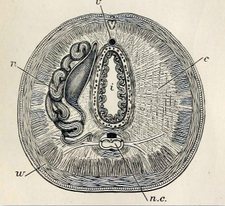Nerve cord
Nerve cord is a term that can refer to either (1) the single, hollow, fluid-filled, dorsal tract of nervous tissue that is one of the defining characteristics of chordates (dorsal nerve cord) and develops into the spinal cord and brain of vertebrates; or (2) the typically solid, ventral, double row of nerve fibers found in some phyla of invertebrates (ventral nerve cord).
In both cases, the term nerve cord references a bundle of nerve fibers that transverse the longitudinal axis of an animal and is an important structure of the animal's central nervous system. However, in the case of chordates, the nerve cord is tubular, hollow, fluid-filled, and runs dorsally, above the notochord and gut tract, while in the case of non-chordates it is solid and runs ventrally, below the digestive tract. They also differ in the the nerve cord of chordates forms by invagination in the embryo, whereas in non-chordates, the nerve cord does not form by invagination.
Ventral nerve cord

The ventral nerve cord is a bundle of nerve fibers, typically a solid double stand (pair) of nerve cords, that runs along the longitudinal axis of some phyla of elongate invertebrates, and forms part of the invertebrate's central nerve system. This nerve cords runs ventrally, below the gut, and connects to the cerebral ganglia. Among the phyla exhibiting ventral nerve cords are nematodes (roundworms), annelids (such as earthworms, and arthropods (such as insects and crafish).
The ventral nerve cord usually consists of a pair connectives, which are partially fused nerve trunks running longitudinally along the ventral plane of the animals, from the anterior to posterior (the thoracic and abdominal tagma in the arthropods), and there are pairs of ganglia that innervate each of the body segments. The segmented ganglia are connected by a tract of nerve fibers passing from one side to the other of the nerve cord called commissures. There are different degrees of fusion.
The complete system bears some likeness to a rope ladder. In some animals the bilateral ganglia are fused into a single large ganglion per segment. This characteristic is found mostly in the insects.
Dorsal nerve cord
The dorsal nerve cord is one of the embryonic features unique to chordates, along with a notochord, a post-anal tail, an endostyle, and pharyngeal slits. The dorsal nerve cord is a hollow cord dorsal to the notochord. It is formed from a part of the ectoderm that rolls, forming the hollow tube, compared to other animal phyla, which have solid, ventral tubes. The dorsal nerve cord is later modified in vertebrates into the central nervous system which is composed of the brain and spinal cord. Dorsal nerve cord is mainly found in subphylum Vertebrata.
The distinguishing features of the Chordata phylum is that they all have, at some time in their life, a notochord, a hollow dorsal nerve cord, and pharyngeal slits.
Dorsal means the "back" side, as opposed to Ventral which is the "front" side of an organism. In organisms with Bipedalism dorsal is the back and ventral is the front. In organisms which walk on four limbs the dorsal surface is the top (back) and the ventral surface is the bottom (belly).
See also
- ventral nerve cord in arthropods
- nerve net in cnidaria and echinodermata phyla
See also
- Dorsal nerve cord in Chordates
- Nerve net in cnidaria and echinodermata phyla
- Protocerebrum
- Deutocerebrum
- Tritocerebrum
ReferencesISBN links support NWE through referral fees
- Hickman, Cleveland and Roberts L. Keen S. Larson A. Eisenhour D. Animal Diversity, 4th, New York: McGraw Hill. ISBN 978-0-07-252844-2.
External links
Credits
New World Encyclopedia writers and editors rewrote and completed the Wikipedia article in accordance with New World Encyclopedia standards. This article abides by terms of the Creative Commons CC-by-sa 3.0 License (CC-by-sa), which may be used and disseminated with proper attribution. Credit is due under the terms of this license that can reference both the New World Encyclopedia contributors and the selfless volunteer contributors of the Wikimedia Foundation. To cite this article click here for a list of acceptable citing formats.The history of earlier contributions by wikipedians is accessible to researchers here:
The history of this article since it was imported to New World Encyclopedia:
Note: Some restrictions may apply to use of individual images which are separately licensed.
